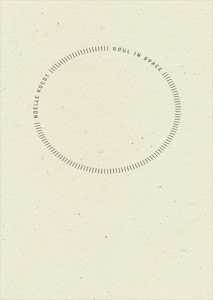By Emily May Anderson
The poems in Soul in Space, Noelle Kocot’s sixth collection, spark across its pages like synapses firing in the brain. Arranged in four sections with different formal conventions, the book doesn’t tell a coherent story, but, like the soul of the title, travels widely while retaining its own voice throughout.
In the Acknowledgments, Kocot credits her editor (Joshua Beckman at Wave Books) with arranging the book into its four numbered sections. The organization works, and it’s hard to imagine the sections being composed without that structure in mind, they flow so well.
The first section of the book comprises many short, spare poems, a majority utilizing couplets and triplets. The opening poem “Talk” begins by introducing the book’s speaker/soul in conversation with her body: “My body is / A little / Green sea.” It concludes with the invitation: “O little sea, // O my body, / Sit here with me / While I just talk.” The reader also feels invited in, and as the section continues, we find ourselves listening in as the speaker intimately observes and reflects on the world. Many of the poems in the first section are very short imagistic pieces, some haiku-like. For example, “The 4th Day After Quitting Cigarettes” reads in its entirety,
The sun rises, too,
Over my water-
Logged heart.
Other poems are explicitly concerned with language, the field in which this speaker plays. “-ied” refers to “The downtrodden verbs / Which direct you // To a place where all things / live.”
From the first section of self-contained images, the book moves to a second section composed of either a series of untitled pieces or a single long poem, all in single-line stanzas. The lack of titles makes it impossible to know, and each of these poems/parts focuses on an unnamed, amorphous “it,” which perhaps can be read as the soul or the universe. The “it” shifts throughout the section, inhabiting different emotional states. “There it stood, naked and ashamed,” at the beginning of the section, but later it is described as the speaker’s “mother. // It screamed me into this world.” It is mundane and “liked looking at pictures of cats / on the computer.” It is vulnerable; “It looked into his eyes once and thought, save me.” Ultimately, the section, or poem, ends with the triumphant declaration, “Yet it lives and moves and has its being.”
The third section of the book is composed entirely of unrhymed sonnets. There are more bodies in these poems, more “we” and “you.” Who those bodies belong to and how they relate is not always clear, but sometimes at least there is a sense of human connection which had been missing earlier in the book. “Present,” for example ends with the lines,
I want nothing, and I want to give you
Nothing. This is why I say, hold
Me, as the many-limbed hunk of
Earth spins and spins, knocks us around.
In other poems, the body may simply be metaphorical. In “Housewarming,” the speaker tells us that “On the backbone of ambiguity stands // a pale body.” Ambiguity itself is a key feature of these poems, and while some possess a clear feeling, others come across as downright baffling.
The fourth and final section of the book is the most diverse in form. Some poems utilize the single-line stanzas of the second section, others use the couplets or tercets of the first section, others appear as one long stanza. While some of these poems are also impossible to pin down (“The Rest Is Assured in the Brightness” as one example), others provide some of the clearest scenes of the book (“Letters,” “March Scene,” “Poem for My Stepfather”). The book ends with “This Is the Day,” a poem of awakening and continuation. “Morning kicks me awake,” the speaker begins, “the / Razorburn of sun, the fading / Scar of moon. I am not lost.” In spite of the harshness of the world, the speaker is grateful to be here. “There is art to / Be had, and song,” she says, and later, “For now, all is / As it should be. Love on the other / sides of the walls, the grapefruit,” the simple pleasures of body and soul continuing on through another day.
Readers who prefer poetry with clear characters and narrative threads will likely find Soul in Space to be a frustrating and challenging book. On the other hand, readers who enjoy the play of language, image, and consciousness will find much to admire and enjoy here.
Soul in Space
By Noelle Kocot
Wave Books (2013)
ISBN: 97811933517742










